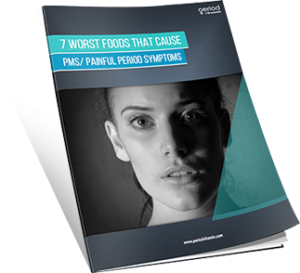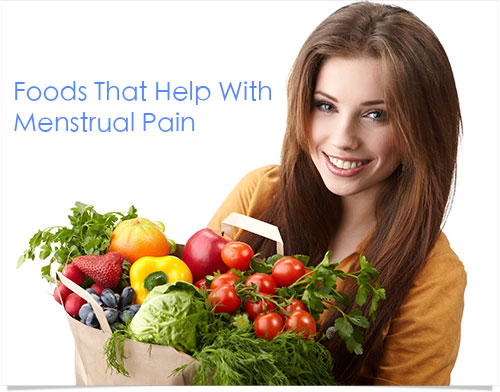 Millions of women around the world suffer from something called pre-menstrual syndrome. This occurs in the weeks preceding the woman starting her period or menstrual cycle. Pre-menstrual syndrome consists of a wide variety of physical and psychological symptoms that can occur anytime from a few weeks before menstruation to a few weeks after the menses or bleeding stops.
Millions of women around the world suffer from something called pre-menstrual syndrome. This occurs in the weeks preceding the woman starting her period or menstrual cycle. Pre-menstrual syndrome consists of a wide variety of physical and psychological symptoms that can occur anytime from a few weeks before menstruation to a few weeks after the menses or bleeding stops.
This happens because there are several stages to the menstrual cycle and a woman’s body goes through many changes during this time. The usual time frame for this cycle is anywhere between twenty eight and thirty one days. The menstrual cycle has 5 distinct stages and different changes occur and different symptoms occur during these stages.
The stages are: premenstrual stage, follicular stage, luteal stage, period (bleeding) stage and post menstrual stage.
The biggest changes that occur during any of these stages are hormonal. For instance in the follicular stage there is an abundance of estrogen released into the body that causes a hormonal imbalance. In the luteal stage there is an abundance of progesterone released that then overpowers the estrogen to cause an entirely different hormonal imbalance. During the pre-menstrual stage there are the beginnings of the estrogen release and following the period stage you can have another release of estrogen that causes some women to have post menstrual symptoms.
Inflammation and prostaglandins also play a role during the menstrual cycle in respect to pain and discomfort and escalating it. The multitude of symptoms that oppress women during the menstrual cycle can include bloating, abdominal cramps, mood swings, irregular and heavy bleeding, headaches and migraines, back aches, acne, insomnia, weight gain, food cravings, light sensitivity, vomiting, and nausea.
“According to the National Women’s Health Information Center at the Center for Disease Control and Prevention (CDC), as many as 75 percent of menstruating women have some PMS symptoms.” www.altmd.com/Articles/Ayurveda-for-PMS
Over the years there have been many medical treatments for some of these symptoms including pharmaceuticals and over the counter (OTC) drugs. The over the counter medications Pamprin and Midol were developed and sold as treatments for pms in general. Analgesics (pain relievers) NSAIDS (non-steroidal anti-inflammatory drugs), anti-depressant medications and sleep aides have also been used. None of these medications treated all of the symptoms of pms and some worked better for some women than for others. They can also be quite expensive.
Throughout recorded history women have also turned to herbal remedies, vitamins and minerals, homeopathic and natural remedies as well. Because of the vitamins and minerals present in their purest forms in some foods, there are foods that can lessen, prevent and help to ease menstrual cramps and decrease the other pms symptoms.
There are specific foods to eat while on your period, when you have menstrual cramps or want to regulate your menstrual cycle and decrease your pms symptoms.
We will look at list of these foods, what vitamins and/or minerals they provide and what pms symptoms they address.
We will also look at why women have food cravings during their menstrual cycle and what foods they crave. There are anti-inflammatory foods, anti pms foods, comfort foods and mood enhancing foods that women can turn to during menstruation.
There is also an Indian way of life called Ayurvedic that is holistic and based on eating specific healthy foods based on your body style and holistic healing. It comes from the Vedic culture of India. Ayurvedic is a system of medicine in India that has been popular for over 5000 years. The Ayurvedic system is based on creating a balance within the physical, mental and spiritual centers of the person. The basic belief is that the human being is rooted in and made of the components of all life – water, earth, fire, air and ether. The Ayurvedic lifestyle is one of discipline, control and a holistic sense of being a part of creation not above it.
The Ayuredic system begins with detoxification of the body and the use of herbs, minerals and practices such as yoga to heal any maladies. So how can the Ayuredic foods help with pms? It is a way of looking at food from the Ayuredic discipline and that leads to foods that will help with the symptoms of pms and foods to avoid when you have pms.
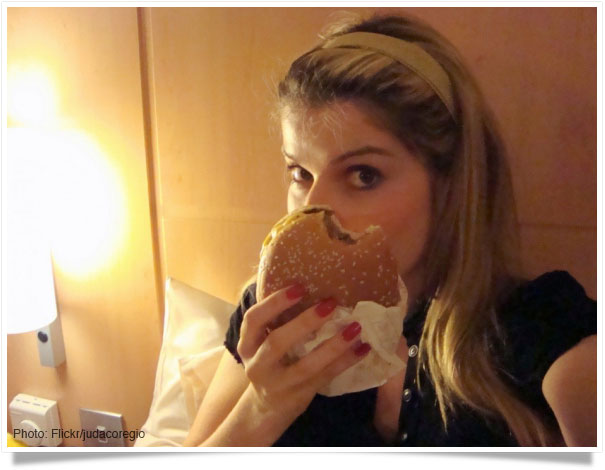 Why do women crave certain foods during their periods and how can food affect the menstrual cycle?
Why do women crave certain foods during their periods and how can food affect the menstrual cycle?
Women will tell you that during their menstrual cycles they often find themselves craving things like salty food, junk foods, raw food, spicy and greasy food.
Why do women crave these types of foods that are not necessarily the healthiest or the easiest to digest?
The Ayuredic system has been in use by women for over five thousand years. There are three major elements to the Ayuredic system and these are called doshas.
The three doshas are Kapha, Pitta and Vata.
- Kapha refers to the balance of the body’s weight, lubrication and structure. Food should be eaten warm not cold and exercise is essential to balance.
- Pitta refers to digestion of food, balance of right and wrong and sensory perception. This is the dosha we will pay the most attention to.
- Vata refers to movement and the balance of movement in the body. Things like meditation and yoga are important here as well as eating meals warm not cold and never raw.
If you follow the rules of Ayuredic then each of these doshas will treat different pms symptoms. The Kapha governs the symptoms of weight gain, bloating, cramps, and depression. The Pitta dosha deals with the pms symptoms of cramping, acne, irritability and anger. The Vata dosha treats the symptoms of headaches or migraines, mood swings, insomnia and anxiety. The foods recommended by the Ayuredic are iron rich foods, natural foods and what we would call today healthy foods. Fresh fruits and vegetables are also encouraged. Green leafy vegetables contain high iron content.
So what food is good to eat when you are on your period?
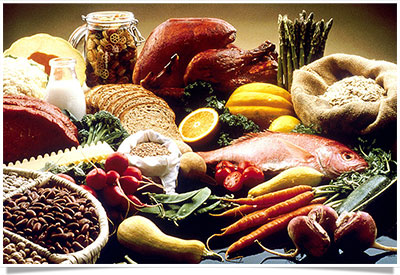 “Studies have shown that certain vitamins of the vitamin B complex are important in the nerve-related chemical synthesis that are associated with premenstrual syndrome or PMS.
“Studies have shown that certain vitamins of the vitamin B complex are important in the nerve-related chemical synthesis that are associated with premenstrual syndrome or PMS.
This study attempted to see if vitamin B, in diet and in the form of vitamin supplements, plays a role in PMS development. The results revealed that taking vitamin B supplements does not predispose to developing PMS.
On the other hand, two of the B vitamins, thiamine and riboflavin, taken from dietary sources, reduce the risk of PMS by 35 percent if consumed for two to four years” www.huffingtonpost.com/2011/07/26/foods-fight-pms
Here are some food that will help with pms symptoms: Chicken breasts, whole grains, nuts, yogurt, bananas, sweet potatoes, beans, tuna fish, salmon, other fruits and nuts, seeds, celery, carrots, wheat germ and vegetable oils, brown rice, avocado, asparagus, and oily fish, lentils, broccoli greens and other greens.
Foods To Avoid During Menstruation
Foods to avoid include chocolate (substitute carob), processed sugars, soda, caffeine, alcohol and fat.
Extra calcium will help to prevent pms symptoms of mood swings and bloating. High fiber foods and vegetables help to balance the hormones and reduce any excess estrogen. Magnesium helps to regulate moods and it is found in many of the foods listed above as magnesium helps to regulate melatonin. Potassium helps to prevent water and fluid retention thus preventing bloating and most cramping. Vitamin B6 helps to regulate the levels of dopamine in your system and can be found in chick peas, oatmeal, salmon, bananas and chicken breasts. Teas containing Valerian or Chamomile are especially good for treating muscle aches and cramping, anxiety and stress.
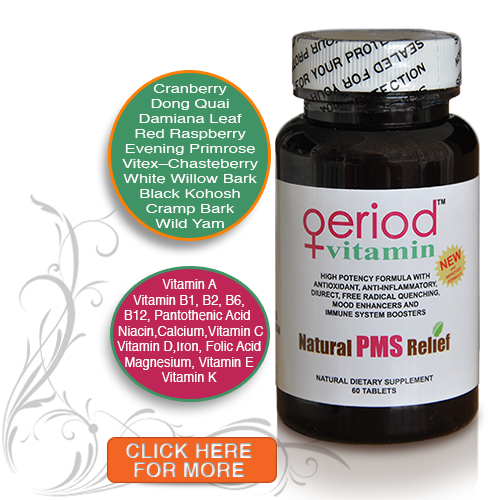 So you can see that there are many foods that contain the vitamins and minerals needed to prevent or treat the symptoms of pms. Many women also have food cravings during their menstrual cycle and this is caused by changes in your blood sugar levels. This is why you want your foods to support a balanced sugar level rather than an unbalanced one. In this way you will eliminate the food cravings during your period.
So you can see that there are many foods that contain the vitamins and minerals needed to prevent or treat the symptoms of pms. Many women also have food cravings during their menstrual cycle and this is caused by changes in your blood sugar levels. This is why you want your foods to support a balanced sugar level rather than an unbalanced one. In this way you will eliminate the food cravings during your period.
If getting the needed nutrients through diet is difficult for you for whatever reasons, try a supplement that has a multitude of these important vitamins, minerals and herbs such as Period Vitamin.
Period Vitamin includes the right amount of iron, B complex vitamins, magnesium and calcium to counter the symptoms of pms. It also contains the ingredients that are good in teas such as valerian, evening primrose oil, cramp bark and other helpful pms herbs.
It is great to get a large portion of your pms fighting vitamins, herbs and minerals from the foods you eat, but it is also good to supplement it with a product like Period Vitamin to insure you are getting enough of the right ingredients in the right doses.


